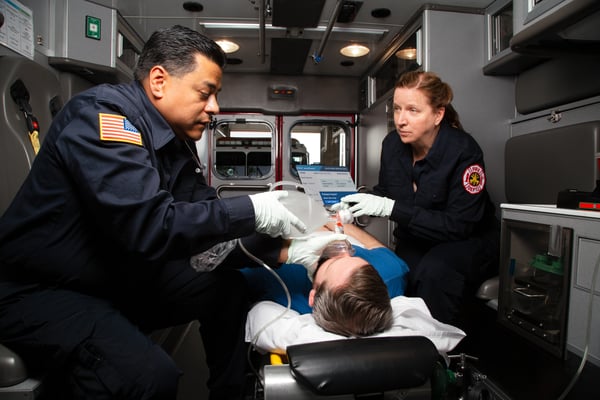News Alert: New ePCR Integration Simplifies EMS Data Management and Enables Better Care Coordination
Why Rapid Access to EMS Data Is Essential for Excellence in Cardiac Systems of Care
In a cardiac system of care, STEMI-referring hospitals and STEMI-receiving centers rely on accurate, timely communication and coordination between their facilities and their EMS partners
Was this information valuable?

In a cardiac system of care, STEMI-referring hospitals and STEMI-receiving centers rely on accurate, timely communication and coordination between their facilities and their EMS partners. Availability of comprehensive patient data that spans the pre-hospital to hospital continuum of care plays an essential role in a range of use cases. For example, emergency department (ED) providers can optimize treatment for cardiac arrest patients arriving via ambulance. Cardiac coordinators and quality teams can perform analysis and conduct activities aligned with The Joint Commission’s Resuscitation Standards for Hospitals. Combined pre-hospital and hospital data also supports reporting required for compliance and hospital certification.
With the abundance of practical uses for this data, it’s easy to make the case for EMS-hospital interoperability. Even so, it’s not the norm for most cardiac systems of care. Why? Rapid access to EMS data is more than important — it’s essential. The cumulative impact of interoperability on critical care, compliance, quality, education, and accreditation makes a compelling value proposition.Impact of Timely, Pre-hospital Data on Critical Care Response
Optimized care for a heart attack patient is built on a strong foundation of data that paints a complete patient picture. Pre-hospital data points may include situational factors leading to the 911 call, social determinants of health observed onsite, and the patient’s medical history, in addition to details of treatment administered. Using leading-edge technology solutions, EMS can transmit critical 12-lead data from the field to the receiving hospital while the patient is still in transport. With the help of HL7 interoperability technology that shares data in near-real time, clinicians can see the entire patient report, including EKG images, vitals, documented medical history, demographics, and even insurance coverage in the hospital electronic medical record (EMR) as soon as the patient care report (PCR) is submitted. Access to this information gives the ED team a broader vision of pre-hospital care prior to patient arrival. As a result, door-to-balloon times improve, as do outcomes.Value of Accessible, Comprehensive Patient Data for Cardiac Coordinators and Quality Teams
Beyond immediate patient care, cardiac coordinators, QA staff, and interdisciplinary teams focused on practice and system improvements have ongoing needs to reference, extract, and analyze patient care data that spans the continuum of pre-hospital and hospital interventions. Cardiac specialty hospitals and critical access hospitals rely on comprehensive patient data for many reasons, including:- Compliance with current Joint Commission resuscitation care requirements
- QA and performance monitoring (facility-level, system-level, and regional initiatives)
- Education and training for hospital staff, EMS partners, and the community at large
- Outcome follow-up for EMS partners
- Identification of evidence-based practice and performance improvement opportunities (e.g., JCAHO PI.01.01.01, PI.03.01.01, and PC.02.01.20)
- Hospital and cardiac program accreditation requirements
- Reporting (hospital board, governing agencies, cardiovascular data registries)
Commonly, STEMI reports need to be completed within 24 hours of patient arrival at the hospital. QA staff review the patient’s EMR to identify live time trends, door-to-balloon times, room turnovers, restenosis, or other complications. They look for outlier metrics and anything that requires timely, corrective action. When available, pre-hospital data patient documentation will include first medical contact, time of first EKG transmission, 12-lead information, vital signs, and more. It can explain factors such as a longer than normal transport or door-to-balloon time. For example, the PCR will capture any unusual circumstances in the patient’s location, health particulars, or even communication limitations in areas with sub-optimal cellular coverage. However, access to pre-hospital data is dependent on the EMS provider finalizing and sharing the PCR, which can be a surprisingly time-consuming process involving faxes, document scanning, and manual data input.
Time is of the essence for QA activities; yet in an age when near-real time digital transfer of information is taken for granted (think everything from online banking to your favorite streaming service), there is a significant interoperability gap between pre-hospital and hospital providers due to the necessity for EMS to leave or fax paper "drop sheets" to receiving facilities. Critical pre-hospital assessment and intervention information typically is not available to the receiving clinicians who are responsible for safely continuing care.
Leveraging Technology To Close the Interoperability Gap and Power Data-driven Improvements
The interoperability gap can be closed by implementing an HL7 interface like ZOLL Care Exchange, which solves the problem of lagging pre-hospital data. Best-in-class solutions can automatically NEMSIS-standardize ePCR datasets and import them into the EMR, meeting compliance requirements and providing clinician transparency. Clinical feedback and visibility into the patient care history can be accessed via a single, platform- and device-agnostic tool. From the get-go, hospital staff responsible for reporting, quality, education, and compliance have access to comprehensive patient data that spans the continuum from the 911 call to eventual post-resuscitation care (essential information for quality assessment).
Pre-hospital and hospital patient data collected and compiled by the hospital, including the number and location of cardiac arrests, resuscitation outcomes, and transfers to facilities with a higher level of care, is readily available in a format that supports a range of analysis and reporting activities. Teams responsible for improving resuscitation performance have visibility into complete cardiac arrest data to help identify opportunities and drive QI initiatives. Outcome data can be easily reported out to partner EMS agencies as part of ongoing collaborations to improve pre-hospital care and coordination.
Return on HL7 Investment
For hospitals that are evaluating the costs and benefits of HL7 data exchange, there will inevitably be many questions coming from a range of stakeholders. As is the case with any information technology initiative, questions like, “How much does it cost?” and “Can we afford it?” are likely to be top of mind. While the investment cost cannot be dismissed, there are other, more targeted questions that can help decision makers ascertain the true value of the investment. The opportunity cost of not implementing HL7 may be significantly greater than meets the eye. In addition to staff workflow inefficiencies, lack of timely, comprehensive patient data inhibits performance, which can have a downstream dampening effect on revenue. Maintaining quality and continuously improving systems and patient outcomes is an important success driver for business development, as well as for accreditation and community reputation.
Some questions hospitals in the cardiac system of care should consider, in addition to calculating the financial return on investment (ROI), are:
- Is it important to obtain the PCR?
- How difficult or easy is it to obtain PCR? What happens if the PCR isn’t available upon request?
- Does lag time in obtaining the PCR impact ED team readiness, clinician transparency, or QA workflows?
- How much time does QA staff spend requesting and waiting for the PCR for any patient population including STEMI, stroke, code/resuscitation, infectious disease/COVID, and trauma, etc.?
- How much time is spent scanning, re-typing, and reformatting PCR data to import into the EMR?
- How is the PCR data used by providers, QA staff, cardiac coordinators, health information managers, and hospital executives?
- How could patient outcomes and quality performance be improved by receiving pre-hospital data in near real time?
- Does providing patient outcomes back to EMS partners improve pre-hospital care, and is this required for certification compliance?
- How much time and money could be saved by eliminating manual processes? (Try this Hospital ROI Calculator)
The Case for EMS-Hospital Interoperability
From faster treatment intervention, to reduced QA workload, to compliance, to more efficient reporting, HL7 data exchange improves patient safety, outcomes, and continuity of care. EMS providers can share PCRs and EKGs with hospitals electronically, in near real time. At the ED, patient hand-off is streamlined with no wait time or need for barcode readers. Cardiac coordinators and QA staff can access complete patient information from incident onset through discharge, in near real time and later, for a variety of analysis and reporting needs.
Learn More About HL7 Data Exchange by Watching the Webinar:
"Compliance, Accreditation, and Patient Safety With Pre-hospital Emergency Care."Download the Complimentary eBook:
The Case for EMS-Hospital InteroperabilityRelated Posts
4 Must-have Data Points for Dispatch-Billing Alignment and Maximum Reimbursement
How STAT MedEvac Connected Device, Software, and Data Technology To Enhance QA and Elevate Care
ZOLL Pulse Blog
Subscribe to our blog and receive quality content that makes your job as an EMS & fire, hospital, or AR professional easier.
ZOLL Pulse Blog
Subscribe to our blog and receive quality content that makes your job as an EMS, fire, hospital, or AR professional easier.




